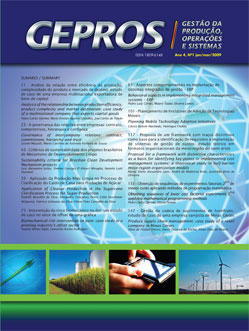Biomechanical risk intervention on pain: case study in a printing industry’s offset sector
DOI:
https://doi.org/10.15675/gepros.v1i1.736Abstract
The presence of risk factors for developing Work Related Occupational Disorders (DORT) is emphasized in several activities. The purpose of this study was to verify the correlation that exists between biomechanical risk and the presence of pain in 18 employees in the offset sector of a printing establishment. The methodology ap- plied was the RULA Method (Rapid Upper Limb Assessment) and Corlett and Bishop’s modified Diagram. Data analysis shows the presence of pain appearing and/or increasing along the workday. It was not possible to cor- relate it with age and work time of the collaborators. The points with larger indications of pain were ankles and feet followed by shoulders, arms and upper back. The biomechanical risk degree revealed an average of 5.21± 1.59 demanding larger investigation and changes soon. It was concluded that according to results achieved by this research, there is a correlation between biomechanical risk and the presence of pain in the offset sector of the printing establishment studied. We suggest the continuity of this study, aiming at a larger investigation on topics found and suggestions for aspects requiring changes, always focusing on the improvement of workers’ occupational health. Keywords: Biomechanical risk; pain; RULA method; printing industry.Downloads
Published
How to Cite
Issue
Section
License
O(s) autor(es) do artigo autorizam a publicação do texto na revista e garantem que a contribuição é original e inédita, não estando em processo de avaliação em outra(s) revista(s). As opiniões, ideias e conceitos emitidos nos textos são de inteira responsabilidade do(s) autor(es), não sendo a revista responsável por tais conteúdos.
Os editores da revista reservam o direito de efetuar ajustes textuais e de adequação às normas da publicação, caso necessário.
Os autores mantêm os direitos autorais sobre o trabalho e concedem à revista o direito de primeira publicação, sendo o trabalho simultaneamente licenciado sob a Attribution 4.0 International (CC BY 4.0), o que permite o compartilhamento do trabalho com reconhecimento da autoria e publicação inicial nesta revista.
Os autores têm autorização para firmar contratos adicionais, separadamente, para distribuição não-exclusiva da versão do trabalho publicada nesta revista (ex.: publicar em repositório institucional ou como capítulo de livro), com reconhecimento de autoria e publicação inicial nesta revista.












